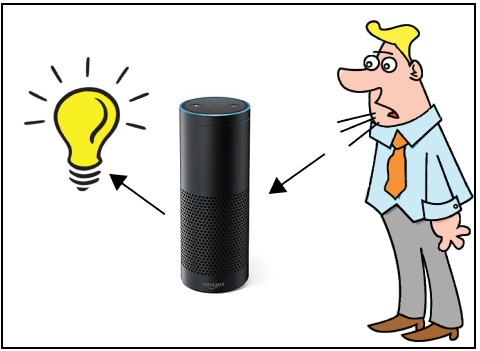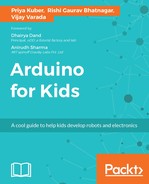Things you will learn about in this chapter are as follows:
- How things around you work
- How to ask questions when you are learning something new
- How to carefully record your observations
Have you ever wondered how things around you seem to talk to each other? How does your garage door know when to open? How does your night-lamp know when to switch the light on and off? How does your computer connect to the Internet and download interesting videos?

All the problems in the world are solved by one word-invention.
The word In-ven-tion originates from the Latin word Inventio, which means finding out. Human beings are called intelligent as they are able to understand, communicate, and change their surroundings. People who make these changes are called inventors.
Since prehistoric times, inventors have held a great power over the rest of humanity. Imagine a world without fire! Humans would not have been able to defend themselves or cook food. Imagine a life without wheels, where humans had to carry heavy weight on their backs. Every inventor has had some positive contribution to the society. It is cool to be an inventor. Inventors are no less than superheroes.
However, becoming an inventor is not an easy task, but so wasn't humans visiting the moon! Every human has the ability to be curious, ask questions, understand, learn, team-up, and build a solution. All it takes is taking one step at a time, just like climbing a set of stairs. Always imagine your solution at the top of a flight of stairs, break down your problem into small questions, connect those questions to your existing knowledge base, learn more from your available resources-be it friends, books, elders or internet. Expand your knowledge in related fields, figure out your solution. Try to build your solution, if it works, there you go, you have an invention! If not, think harder, question more!
And you young makers are invention-superheroes! Isn't it cool?
The first step to gaining these superpowers is to keep an observation-notebook. This observation notebook will be your companion throughout your journey towards a desired solution.
Now that you have your own invention-notebook, write a question. What fascinates you in your everyday life? There is an answer for everything it is a matter of asking the right question.
A good invention-notebook is filled in regularly, and superheroes don't not give up till they have solved the problem!
The internet is a great tool to solve problems-let's call it the helpful genie in the bottle. During the course of building things with me, you will need to rub this bottle a lot and call the genie!
Brace yourselves, young invention-superheroes, you and your genie are ready to embark upon this wonderful world of inventing solutions to problems!
Now that we agreed that you want to solve problems, how do we define or recognize a problem?
A problem is nothing but a solution with a LOT of gift wraps. It is an opportunity for you to increase your knowledge base. The more data you have in your knowledge base, the harder problems you can solve, and the better your solutions can be.
Problems can be observed by you, or reported to you by others. Understanding the problem is the first step. Some good questions to ask would be as follows:
- What is the end result I want?
- Does any solution currently exist to solve it? (Search the internet, use your genie!)
- Is the current solution the best way it can be solved?
When you get the answer to the last two questions as NO, you try to break down the problem into small blocks, just like you chew the food before swallowing.
Take a very simple example: if your younger brother has a problem understanding how your night lamp turns on and off with a switch, you start by making a note in your inventor's notebook:
What do you see in the lamp?
- You see a bulb at the center, a shade, and a tail-like wire plugged into a socket; you write it down.
- Then you see the small switch, which makes the bulb go on and off Note that down too in your notebook. Start asking yourself what is in that switch that makes this lamp go on and off and how can it be related to the socket? Ask an elder to pull the plug off-try the switch.
- Does the bulb go on and off? No? Note that down in your inventor's notebook.
- Ask the elder to plug in the wire again. Try the switch now? Yes! Make a note of that in your notebook too.
- What did you learn? The lamp works when it is plugged in, and it is controlled by a switch.
- What makes the lamp work? What comes out of the socket? Can you explain it?
- Ask your genie! (Answer on the last page)
